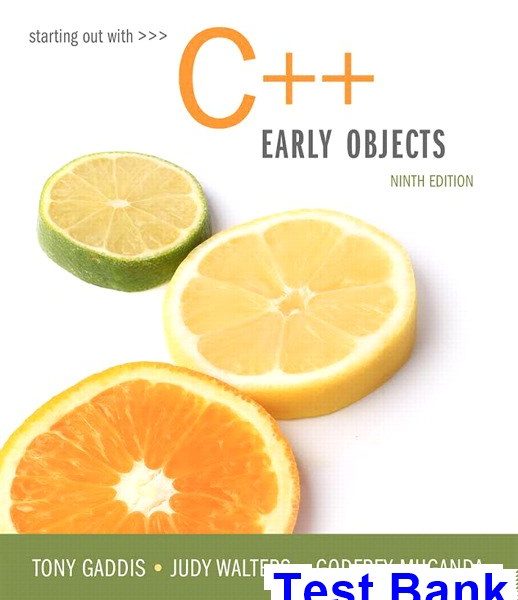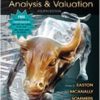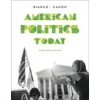Starting Out with C++ Early Objects 9th Edition Gaddis Test Bank
$35.00 Original price was: $35.00.$26.50Current price is: $26.50.
Starting Out with C++ Early Objects 9th Edition Gaddis Test Bank
Instant download Starting Out with C++ Early Objects 9th Edition Gaddis Test Bank pdf docx epub after payment.

Product details:
- ISBN-10 : 0134400240
- ISBN-13 : 978-0134400242
- Author: Tony Gaddis; Judy Walters; Godfrey Muganda
Intended for use in a two-term, three-term, or accelerated one-term C++ programming sequence, this Ninth Edition of Starting Out with C++: Early Objects introduces the fundamentals of C++ to novices and experienced programmers alike. In clear, easy-to-understand terms, the text introduces all of the necessary topics for beginning C++ programmers. Real-world examples allow readers to apply their knowledge in understanding how, why, and when to implement the features of C++. The text is organized in a progressive, step-by-step fashion that allows for flexibility. Building on the popularity of previous editions, the Ninth Edition has been updated and enhanced with new material, including C++11 topics and recent changes in technology.
Table of contents:
Contents Preface xv CHAPTER 1 Introduction to Computers and Programming 1 1.1 Why Program? 1 1.2 Computer Systems: Hardware and Software 2 1.3 Programs and Programming Languages 6 1.4 What Is a Program Made of? 12 1.5 Input, Processing, and Output 16 1.6 The Programming Process 18 1.7 Procedural and Object-Oriented Programming 22 1.8 Case Studies 24 1.9 Review Questions and Exercises 25 CHAPTER 2 Introduction to C++ 29 2.1 The Parts of a C++ Program 29 2.2 The cout Object 33 2.3 The #include Directive 37 2.4 Standard and Prestandard C++ 39 2.5 Variables, Constants, and the Assignment Statement 40 2.6 Identifiers 45 2.7 Integer Data Types 47 2.8 The char Data Type 52 2.9 The C++ string Class 56 2.10 Floating-Point Data Types 57 2.11 The bool Data Type 61 2.12 Determining the Size of a Data Type 62 2.13 More on Variable Assignments and Initialization 63 2.14 Scope 64 2.15 Arithmetic Operators 65 2.16 Comments 68 2.17 Focus on Software Engineering: Programming Style 70 2.18 Case Studies 72 2.19 Review Questions and Exercises 72 CHAPTER 3 Expressions and Interactivity 79 3.1 The cin Object 79 3.2 Mathematical Expressions 85 3.3 Implicit Type Conversion 93 3.4 Explicit Type Conversion 95 3.5 Overflow and Underflow 98 3.6 Named Constants 101 3.7 Multiple and Combined Assignment 107 3.8 Formatting Output 111 3.9 Working with Characters and String Objects 121 3.10 Using C-Strings 128 3.11 More Mathematical Library Functions 133 3.12 Introduction to Files 138 3.13 Focus on Object-Oriented Programming: Member Functions 146 3.14 Focus on Debugging: Hand Tracing a Program 147 3.15 Green Fields Landscaping Case Study; Part 1 149 3.16 Additional Case Studies 152 3.17 Review Questions and Exercises 152 CHAPTER 4 Making Decisions 167 4.1 Relational Operators 167 4.2 The if Statement 173 4.3 The if/else Statement 183 4.4 The if/else if Statement 186 4.5 Menus 192 4.6 Nested if Statements 194 4.7 Logical Operators 198 4.8 Checking Numeric Ranges with Logical Operators 206 4.9 Validating User Input 207 4.10 More About Variable Definitions and Scope 209 4.11 Comparing Characters and Strings 215 4.12 The Conditional Operator 219 4.13 The switch Statement 223 4.14 Enumerated Data Types 232 4.15 Testing for File Open Errors 235 4.16 Focus on Testing and Debugging: Validating Output Results 236 4.17 Green Fields Landscaping Case Study; Part 2 239 4.18 Additional Case Studies 243 4.19 Review Questions and Exercises 243 CHAPTER 5 Looping 255 5.1 The Increment and Decrement Operators 255 5.2 Introduction to Loops: The while Loop 260 5.3 Counters 264 5.4 Letting the User Control the Loop 266 5.5 Keeping a Running Total 268 5.6 Sentinels 269 5.7 Using a Loop to Read Data From a File 271 5.8 The do-while and for Loops 274 5.9 Deciding Which Loop to Use 284 5.10 Nested Loops 285 5.11 Breaking Out of a Loop 288 5.12 The continue Statement 290 5.13 Focus on Software Engineering: Using Loops for Data Validation 292 5.14 Focus on Testing and Debugging: Creating Good Test Data 295 5.15 Central Mountain Credit Union Case Study 298 5.16 Additional Case Studies 303 5.17 Review Questions and Exercises 303 CHAPTER 6 Functions 313 6.1 Modular Programming 313 6.2 Defining and Calling Functions 314 6.3 Function Prototypes 322 6.4 Sending Data into a Function 324 6.5 Passing Data by Value 328 6.6 The return Statement 332 6.7 Returning a Value from a Function 334 6.8 Returning a Boolean Value 338 6.9 Using Functions in a Menu-Driven Program 340 6.10 Local and Global Variables 343 6.11 Static Local Variables 349 6.12 Default Arguments 353 6.13 Using Reference Variables as Parameters 357 6.14 Overloading Functions 365 6.15 The exit() Function 369 6.16 Stubs and Drivers 373 6.17 Little Lotto Case Study 376 6.18 Additional Case Studies 381 6.19 Review Questions and Exercises 381 CHAPTER 7 Introduction to Classes and Objects 391 7.1 Combining Data into Structures 391 7.2 Accessing Structure Members 394 7.3 Initializing a Structure 398 7.4 Nested Structures 402 7.5 Structures as Function Arguments 406 7.6 Returning a Structure from a Function 410 7.7 Unions 413 7.8 Abstract Data Types 417 7.9 Object-Oriented Programming 419 7.10 Introduction to Classes 423 7.11 Introduction to Objects 425 7.12 Defining Member Functions 427 7.13 Focus on Software Engineering: Design Considerations 434 7.14 Using a Constructor with a Class 439 7.15 Overloading Constructors 440 7.16 Destructors 443 7.17 Input Validation Objects 447 7.18 Using Private Member Functions 451 7.19 Home Software Company OOP Case Study 454 7.20 Focus on Software Engineering: Object-Oriented Analysis 461 7.21 Additional Case Studies 464 7.22 Review Questions and Exercises 464 CHAPTER 8 Arrays 477 8.1 Arrays Hold Multiple Values 477 8.2 Accessing Array Elements 479 8.3 Inputting and Displaying Array Contents 481 8.4 Array Initialization 487 8.5 Processing Array Contents 493 8.6 Using Parallel Arrays 502 8.7 The typedef Statement 506 8.8 Arrays as Function Arguments 507 8.9 Two-Dimensional Arrays 516 8.10 Arrays with Three or More Dimensions 524 8.11 Vectors 528 8.12 National Commerce Bank Case Study 540 8.13 Arrays of Structures 543 8.14 Arrays of Class Objects 547 8.15 Additional Case Studies 555 8.16 Review Questions and Exercises 556 CHAPTER 9 Searching and Sorting Arrays 567 9.1 Focus on Software Engineering: Introduction to Search Algorithms 567 9.2 Demetris Leadership Center Case Study; Part 1 574 9.3 Focus on Software Engineering: Introduction to Sorting Algorithms 581 9.4 Demetris Leadership Center Case Study; Part 2 589 9.5 Sorting and Searching Vectors 596 9.6 Additional Case Studies 601 9.7 Review Questions and Exercises 602 CHAPTER 10 Pointers 607 10.1 Getting the Address of a Variable 607 10.2 Pointer Variables 609 10.3 The Relationship Between Arrays and Pointers 613 10.4 Pointer Arithmetic 617 10.5 Initializing Pointers 619 10.6 Comparing Pointers 621 10.7 Pointers as Function Parameters 624 10.8 Focus on Software Engineering: Dynamic Memory Allocation 628 10.9 Focus on Software Engineering: Returning Pointers from Functions 632 10.10 Pointers to Structures and Class Objects 635 10.11 Focus on Software Engineering: Selecting Members of Objects 641 10.12 United Cause Relief Agency Case Study 643 10.13 Additional Case Studies 651 10.14 Review Questions and Exercises 652 CHAPTER 11 More About Classes and Object-Oriented Programming 657 11.1 The this Pointer and Constant Member Functions 657 11.2 Static Members 662 11.3 Friends of Classes 669 11.4 Memberwise Assignment 675 11.5 Copy Constructors 677 11.6 Operator Overloading 685 11.7 Type Conversion Operators 721 11.8 Convert Constructors 726 11.9 Object Composition 730 11.10 Inheritance 732 11.11 Protected Members and Class Access 736 11.12 Constructors, Destructors, and Inheritance 742 11.13 Overriding Base Class Functions 747 11.14 Case Studies 750 11.15 Review Questions and Exercises 750 CHAPTER 12 More About Characters, Strings, and the string Class 761 12.1 C-strings 761 12.2 Library Functions for Working with C-Strings 766 12.3 String/Numeric Conversion Functions 778 12.4 Character Testing 781 12.5 Character Case Conversion 786 12.6 Writing Your Own C-String Handling Functions 788 12.7 More About the C++ string Class 794 12.8 Creating Your Own String Class 799 12.9 Advanced Software Enterprises Case Study 811 12.10 Additional Case Studies 813 12.11 Review Questions and Exercises 814 CHAPTER 13 Advanced File and I/O Operations 821 13.1 Files 821 13.2 Output Formatting 830 13.3 Passing File Stream Objects to Functions 838 13.4 More Detailed Error Testing 840 13.5 Member Functions for Reading and Writing Files 844 13.6 Working with Multiple Files 854 13.7 Binary Files 855 13.8 Creating Records with Structures 859 13.9 Random-Access Files 863 13.10 Opening a File for Both Input and Output 870 13.11 Online Friendship Connections Case Study: Object Serialization 875 13.12 Additional Case Studies 880 13.13 Review Questions and Exercises 881 CHAPTER 14 Recursion 889 14.1 Introduction to Recursion 889 14.2 The Recursive Factorial Function 897 14.3 The Recursive gcd Function 899 14.4 Solving Recursively Defined Problems 900 14.5 A Recursive Binary Search Function 902 14.6 Focus on Problem Solving and Program Design: The QuickSort Algorithm 904 14.7 Focus on Problem Solving: Exhaustive and Enumeration Algorithms 908 14.8 Focus on Software Engineering: Recursion Versus Iteration 912 14.9 Case Studies 913 14.10 Review Questions and Exercises 913 CHAPTER 15 Polymorphism, Virtual Functions, and Multiple Inheritance 917 15.1 Type Compatibility in Inheritance Hierarchies 917 15.2 Polymorphism and Virtual Member Functions 921 15.3 Abstract Base Classes and Pure Virtual Functions 926 15.4 Multiple and Virtual Inheritance 931 15.5 Focus on Object-Oriented Programming: Composition Versus Inheritance 940 15.6 Secure Encryption Systems, Inc. Case Study 945 15.7 Review Questions and Exercises 949 CHAPTER 16 Exceptions, Templates, and the Standard Template Library (STL) 957 16.1 Exceptions 957 16.2 Function Templates 969 16.3 Class Templates 978 16.4 Class Templates and Inheritance 984 16.5 Introduction to the Standard Template Library 988 16.6 Case Studies 1003 16.7 Review Questions and Exercises 1003 CHAPTER 17 Linked Lists 1009 17.1 Introduction to the Linked List ADT 1009 17.2 Linked List Operations 1016 17.3 A Linked List Template 1032 17.4 Recursive Linked List Operations 1037 17.5 Variations of the Linked List 1043 17.6 The STL list Container 1044 17.7 Reliable Software Systems, Inc. Case Study 1046 17.8 Additional Case Studies 1049 17.9 Review Questions and Exercises 1050 CHAPTER 18 Stacks and Queues 1055 18.1 Introduction to the Stack ADT 1055 18.2 Dynamic Stacks 1065 18.3 The STL stack Container 1069 18.4 Introduction to the Queue ADT 1071 18.5 Dynamic Queues 1079 18.6 The STL deque and queue Containers 1082 18.7 Focus on Problem Solving and Program Design: Eliminating Recursion 1085 18.8 Review Questions and Exercises 1090 CHAPTER 19 Binary Trees 1095 19.1 Definition and Applications of Binary Trees 1095 19.2 Binary Search Tree Operations 1099 19.3 Template Considerations for Binary Search Trees 1116 19.4 Case Studies 1116 19.5 Review Questions and Exercises 1116 Appendix A The ASCII Character Set 1121 Appendix B Operator Precedence and Associativity 1125 Index 1127
People also search:
Starting Out with C++ Early Objects 9th Edition
Starting Out with C++ Early Objects 9th Edition pdf
Starting Out with C++ Early Objects
|
c++ how to program (early objects version)
|
starting out with c++ from control structures to objects
Related products
Test Bank
Test Bank for Essentials of Business Law and the Legal Environment, 11th Edition: Richard A. Mann
Test Bank
Test Bank for Decision Support and Business Intelligence Systems, 9th Edition: Efraim Turban











